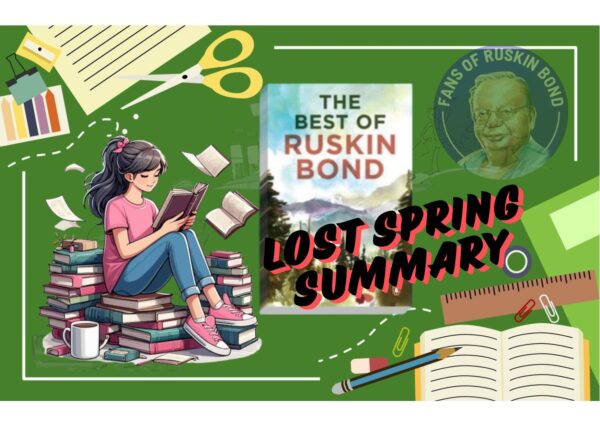“Lost Spring” by Ruskin Bond is a poignant tale that delves into the lives of two young boys, Saheb and Mukesh, living in the slums of India. This literary masterpiece sheds light on the harsh realities faced by countless underprivileged children, juxtaposed against the backdrop of their dreams and aspirations. In this article, we will explore the summary of “Lost Spring” while unraveling its themes, characters, and the profound societal messages it conveys.
The Author and Background
Ruskin Bond, a renowned Indian author, is celebrated for his ability to weave compelling stories that touch the hearts of readers. Born in Kasauli, India, Bond’s experiences growing up in the Indian subcontinent greatly influence his storytelling, and “Lost Spring” is no exception. It was first published in 1999 as part of his collection of short stories titled “A Flight of Pigeons.”
Setting the Scene: A Glimpse into Springs and Childhood Dreams
“Lost Spring” is set in the picturesque town of Dehradun, where the arrival of spring brings hope and rejuvenation. The story introduces us to the concept of lost springs – dreams and opportunities that never materialize for the impoverished children of the slums.
The Characters: Exploring the Lives of Saheb and Mukesh
Saheb, the central character, is a rag-picker who lives with his family in abject poverty. His friend Mukesh, though equally destitute, aspires to be educated and escape the cycle of poverty.
The Plot Unfolds: Saheb’s Plight in the Iron Factory
Saheb’s story takes a tragic turn when he is forced to work in an iron factory, perpetuating a cycle of child labor and exploitation. The iron factory becomes a symbol of lost dreams and the harsh reality of economic disparities.
Dreams Deferred: The Hardships of Rag-picking
The story also highlights the grim existence of rag-pickers, scavenging for a meager livelihood amidst heaps of discarded wealth. The children collect and sell waste materials to make ends meet.
Hopes and Desires: The Role of Education
Mukesh’s desire for education serves as a glimmer of hope in the story. He attends school whenever he can, showing that education is a powerful tool to break free from the clutches of poverty.
Social Realities: Poverty and Exploitation
“Lost Spring” exposes the stark social realities of class divisions and the exploitation of the poor by the affluent. It depicts how systemic inequality traps individuals in a never-ending cycle of poverty.
The Clash of Two Worlds: Symbolism in “Lost Spring”
The story uses symbols like the train and the bangle factory to represent the contrasting worlds of dreams and harsh realities. These symbols add depth to the narrative and emphasize the theme of lost opportunities.
Themes and Messages: What the Story Teaches Us
“Lost Spring” underscores themes of poverty, education, and the clash of dreams with societal constraints. It reminds us to reflect on the privileges we often take for granted and the importance of breaking the cycle of poverty.
The Impact of “Lost Spring”: Reflections on Society
This story continues to resonate with readers, serving as a powerful reminder of the harsh truths faced by marginalized communities worldwide. It urges us to take action to address social inequalities.
The Significance of the Title: Analyzing “Lost Spring”
The title itself is symbolic, representing the lost dreams and aspirations of countless children trapped in poverty. It serves as a metaphor for the untapped potential of young minds.
Literary Techniques: Ruskin Bond’s Narrative Style
Ruskin Bond’s storytelling prowess shines through in “Lost Spring.” He employs vivid imagery, evocative language, and a compelling narrative style that engages readers emotionally.
Why “Lost Spring” Matters Today: A Contemporary Perspective
Even in the modern world, the issues raised in “Lost Spring” remain relevant. Child labor, poverty, and limited access to education are challenges that persist, making this story an essential read.
Conclusion
“Lost Spring” by Ruskin Bond is a timeless masterpiece that transcends generations, inviting readers to contemplate the stark realities of poverty and the enduring power of dreams. It calls upon us to take action to create a more equitable world where no spring is lost.
FAQs
Who is the author of “Lost Spring”? The author of “Lost Spring” is Ruskin Bond, a renowned Indian writer.
What is the central theme of “Lost Spring”? The central theme of “Lost Spring” is the clash between childhood dreams and the harsh social realities faced by underprivileged children.
Who are the main characters in “Lost Spring”? The main characters are Saheb, a rag-picker, and Mukesh, a boy aspiring for education despite his poverty.
What social issues does “Lost Spring” highlight? “Lost Spring” highlights issues such as poverty, child labor, and systemic inequality.
Why is the title “Lost Spring” significant? The title symbolizes the lost dreams and aspirations of children trapped in poverty, reflecting the untapped potential of young minds.

